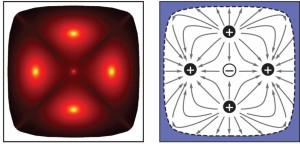
Vortices of bound states in the continuum. The left panel shows five bound states in the continuum in a photonic crystal slab as bright spots. The right panel shows the polarization vector field in the same region as the left panel, revealing five vortices at the locations of the bound states in the continuum. These vortices are characterized with topological charges +1 or -1.
Credit: MIT
Research out of the Massachusetts Institute of Technology has led to a new understanding of how to halt protons, which could lead to miniature particle accelerators and improved data transmission.
Accordingly, this new work could help explain some basic physical mechanisms.
Last year, researchers from MIT succeeded in creating a material that could trap light and stop it in its tracks. Now, the same batch of researchers have conducted more studies in order to develop a more fundamental understand of the process, which reveals that this behavior is connected to a wide range of seemingly unrelated phenomena.

